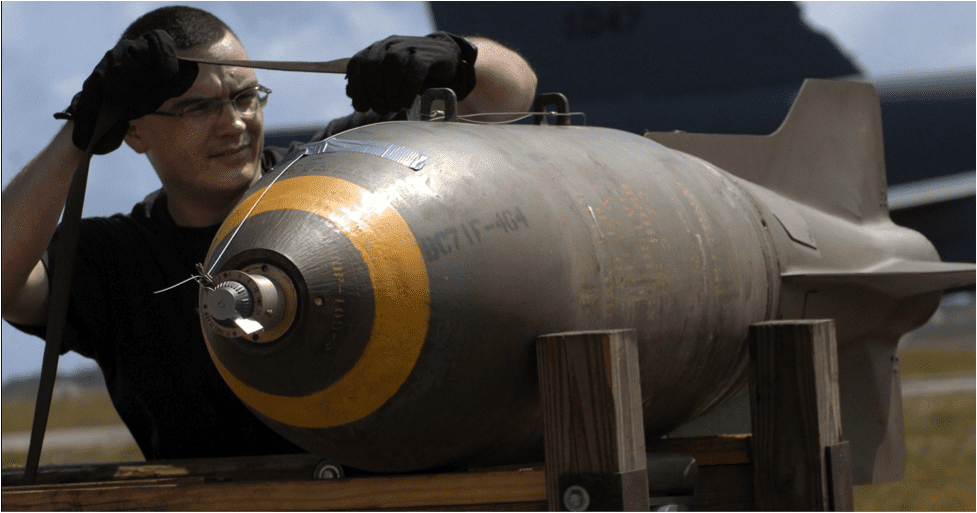Posted on May 05, 2011
When visitors at Pearl Harbor Aviation Museum look at the Japanese bomb replicas on our attack wall, they sometimes ask about the little propellers on the bombs. Obviously, these are too small to make the bomb change directions. Some even notice that one of the bombs has two propellers—one on its tip and one at the tail end of the bomb’s body. The answer to the first question is that the propellers are attached to the fuzes that detonate the bomb. The answer to the second is a bit more complicated.
The answer to the second is a bit more complicated.
Figure 1: Bombs with Propeller Fuzes
Fuzes have two purposes. The obvious one is to cause the bomb to explode. When the bomb makes impact, the fuze has a spike or electrical circuit that detonates the bomb. If the fuze has a spike, that spike is driven into a small detonation charge that sets off the main bomb charge. An electrical fuze uses a spark to set off the detonation charge. Earlier bombs used pyrotechnic detonation—a flame raced down a detonation line into the detonation charge. Pyrotechnic fuzes were not used in World War II aircraft bombs because of their uncertain detonation time. (In case you were wondering about spelling, pyrotechnic fuses are fuses (with an s), while mechanical or electrical detonators are fuzes (with a z).
Fuzes can have various timers built into them to make the blast more effective. Some go off at a given time after arming, but these are hard to time properly when dropped from aircraft. More common are delay timers to delay the detonation for a few fractions of a second. If an aircraft is dropping a bomb on a runway full of aircraft, there should be no delay. However, if the bomb is dropped on an aircraft hangar, there should be a small delay so that it does not detonate as soon as it hits the roof. Armor piercing bombs, which are designed to penetrate armored ship decks, will have fuzes with even longer delays. Proximity fuzes use radio signals to tell when they are near their targets. They then explode even before hitting the target. This allows a greater radius of destruction.
While making a bomb explode is important, fuzes have an even more important function: to prevent the bomb from detonating before it has left the aircraft. Once a fuze is armed, any hard jolt can set it off. Consequently, fuzes are not armed on a bomber with internal bombs until just before the bombs are dropped. For bombs carried outside an aircraft, the bomb fuze must not go live until a safe time after the bomb has left the aircraft.
This is where the little propellers come in. When a bomb carried externally on an aircraft is loaded aboard, a safety pin is placed through the propeller on the fuze so that the propeller cannot spin.
Figure 2: Fuze with Safety Pin
This pin attaches to a line connected to the aircraft. When the bomb is dropped, the line stays with the aircraft. Almost as soon as the bomb falls away, the pin attached to the line is yanked out of the fuze. Now the propeller is free to turn. As the bomb falls, the propeller begins to spin slowly. This spinning drives a screw which pushes the detonator spike or electrical connection into the detonator charge. The bomb is now armed and will explode at the proper time.
Figure 3: Wire Attached to Safety Pin
The two propellers on one of the bombs? These allow the bomb to have two fuzes. One might be set to go off on impact, while the other might have a small delay. The former would be right for ground targets, while the other would be best for bombs falling through hangars.
Both fuzes will have pins attached to the aircraft by wires. The pilot or bombardier holds or releases these wires. If the front fuze is to be used, the pilot keeps the wire for that fuze attached to the aircraft but releases the wire for the aft fuze. Now when the bomb falls away from the aircraft, the safety pin will be yanked out of the front fuze. The timer built into the front fuze will detonate the bomb. On the rear fuze, the wire will fall with the bomb and so will not yank out the safety hook.
To give an example, suppose that the pilot has a front fuze for immediate impact and a rear fuze for delayed impact. To hit aircraft on the ground, the pilot would hold the front wire and release the rear wire. This would arm the front fuze. However, if the pilot wishes to bomb a hangar, he will hold the rear wire and release the front wire. Now only the rear fuze will be armed, allowing the bomb to pause to reach the bottom of the hangar.
From the pictures in this article, you can see that fuzes are rather simple devices. This allows them to be rugged. However, while using a safety pin attached to a wire might seem crude, it usually worked well.


